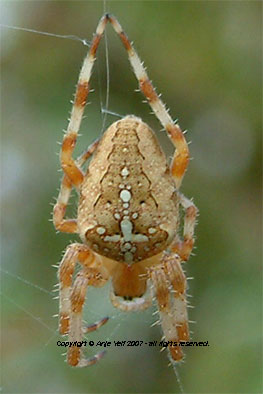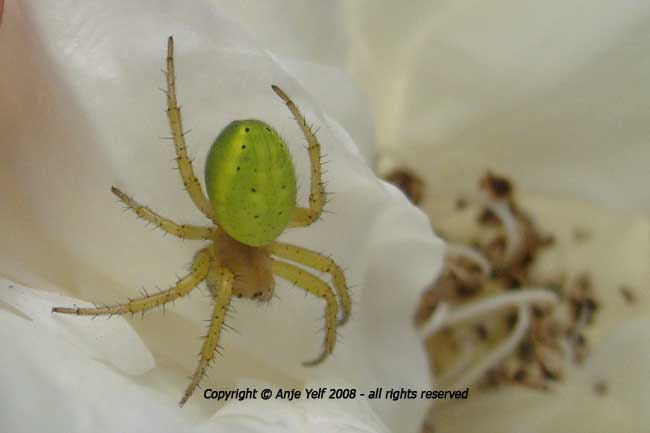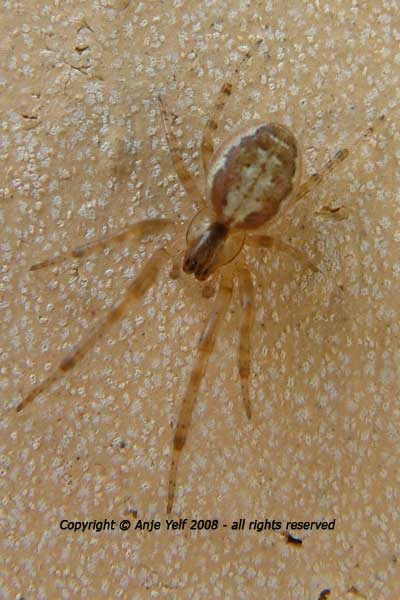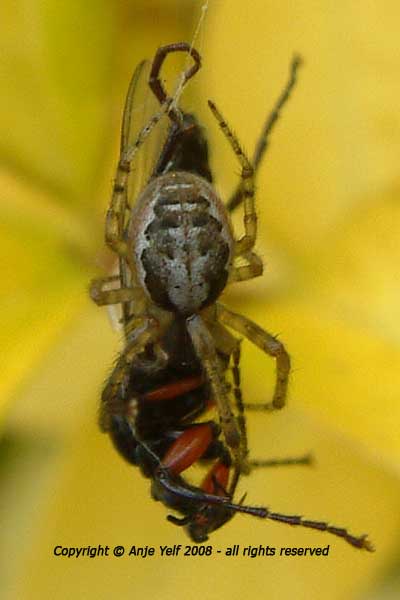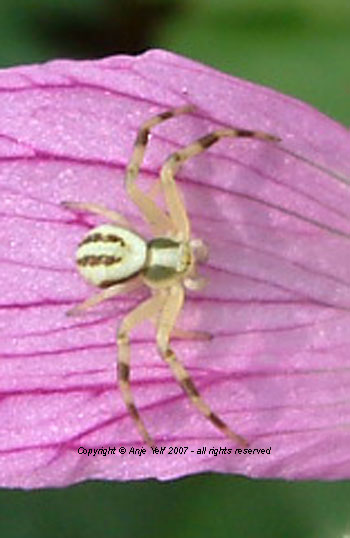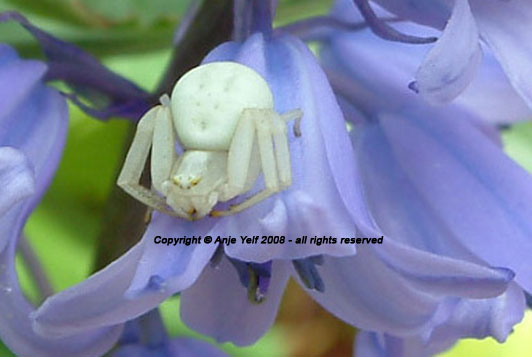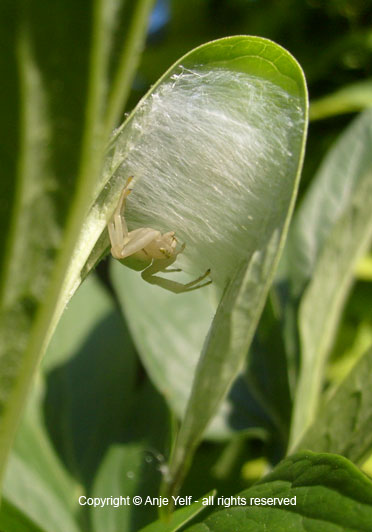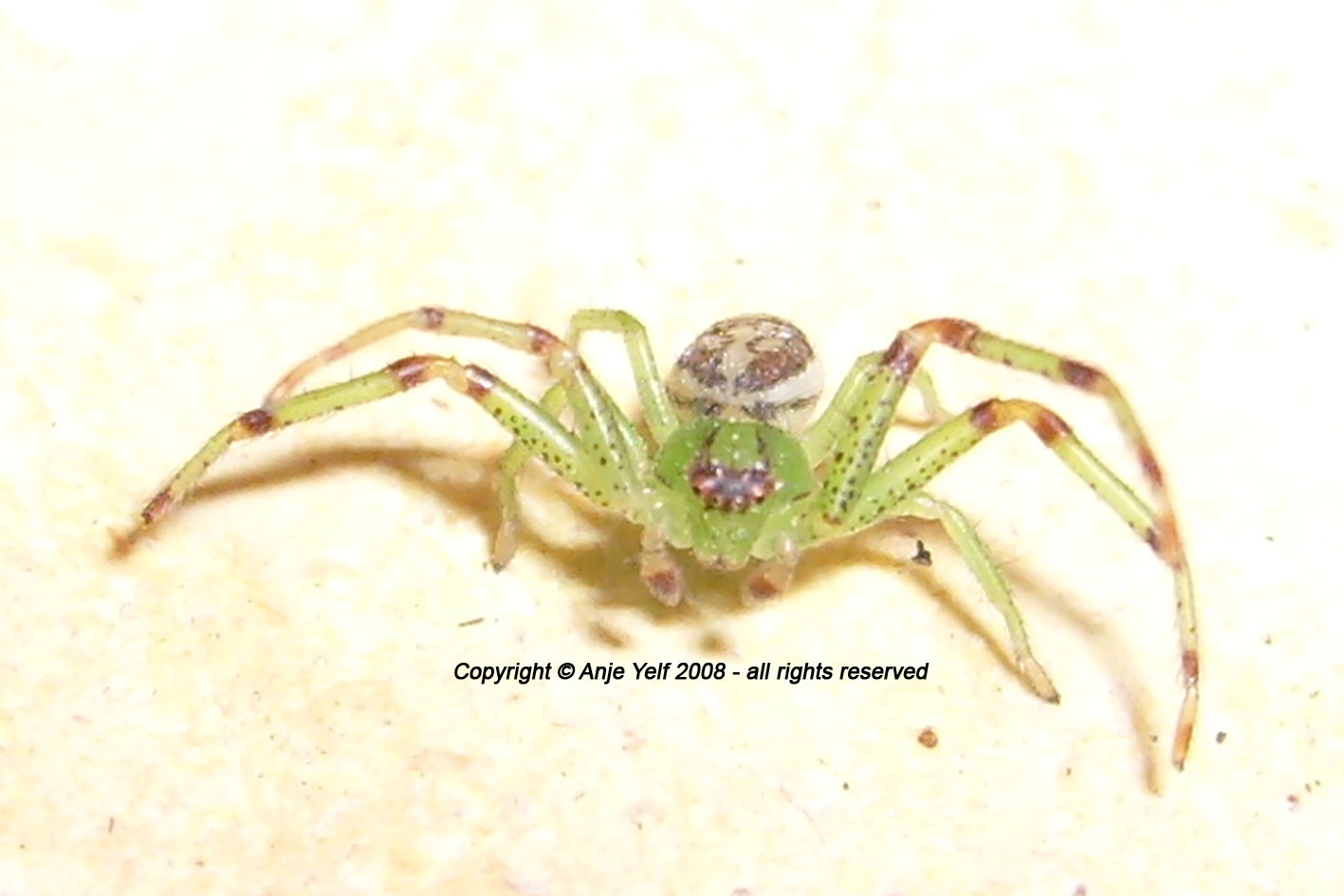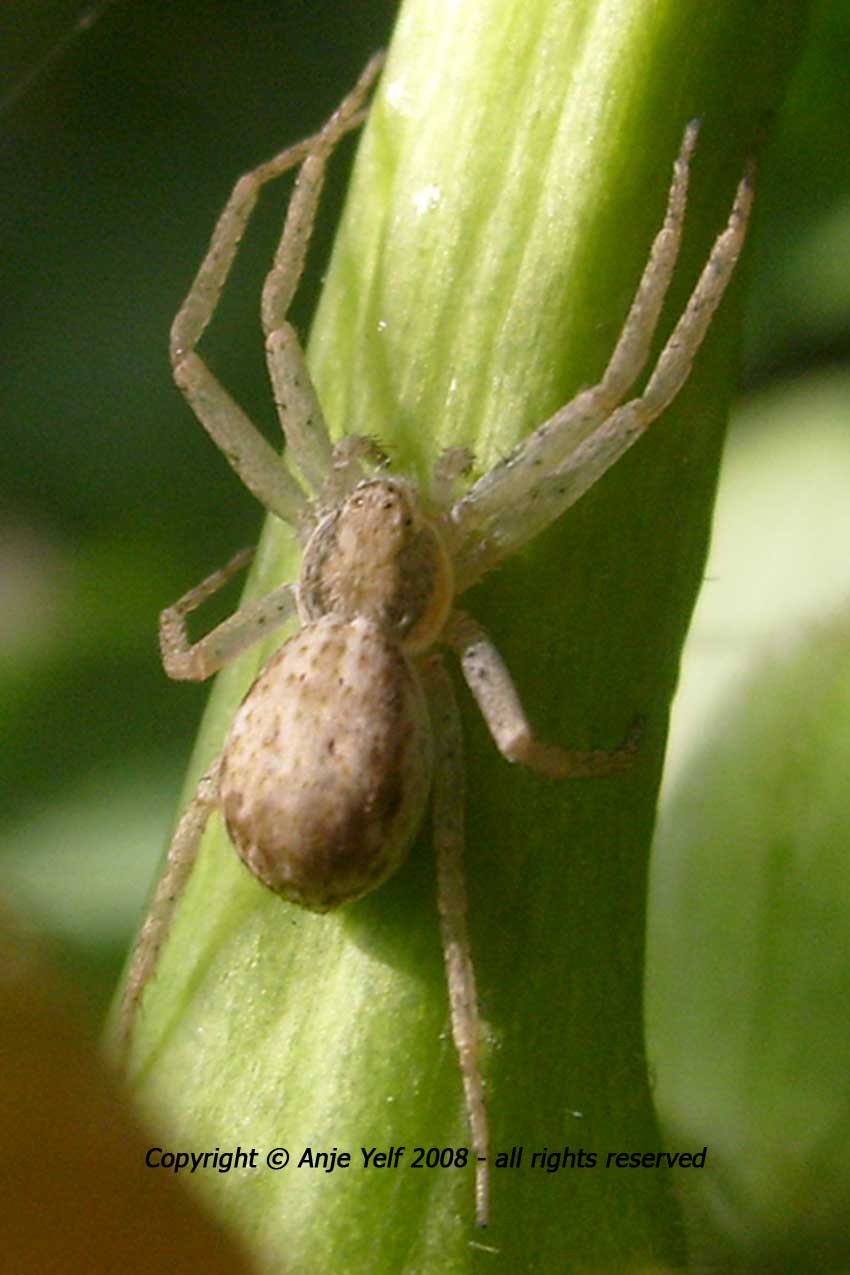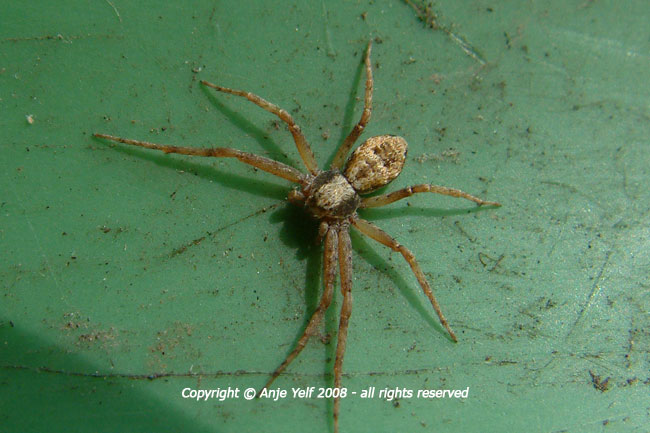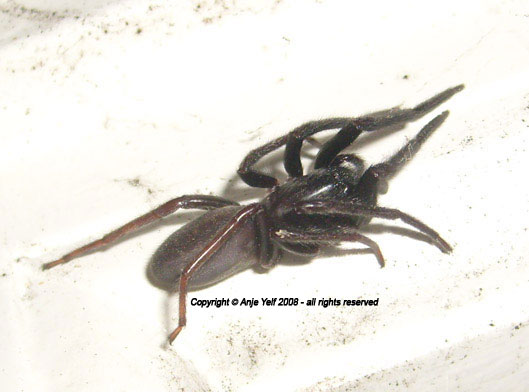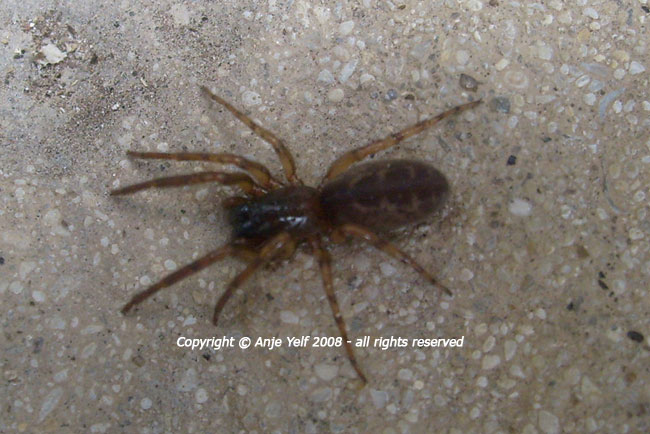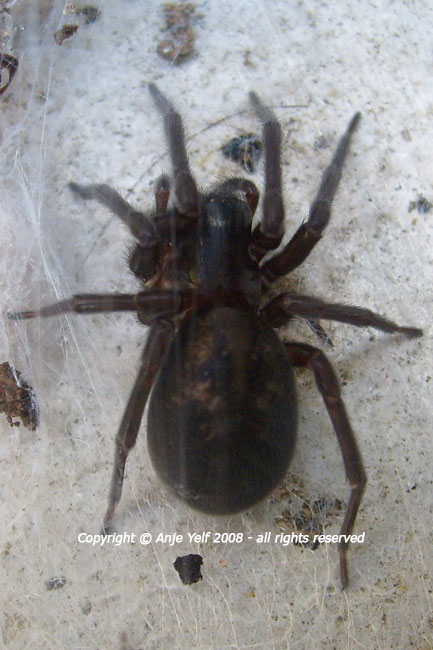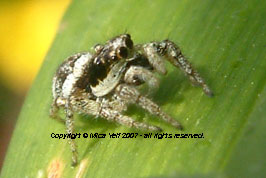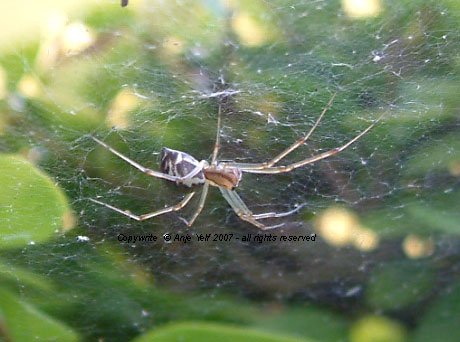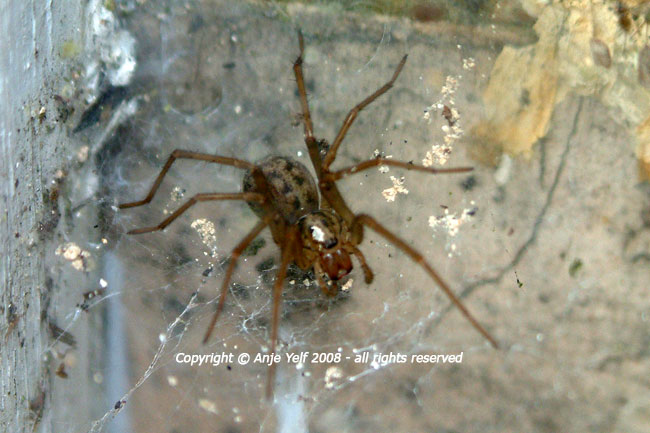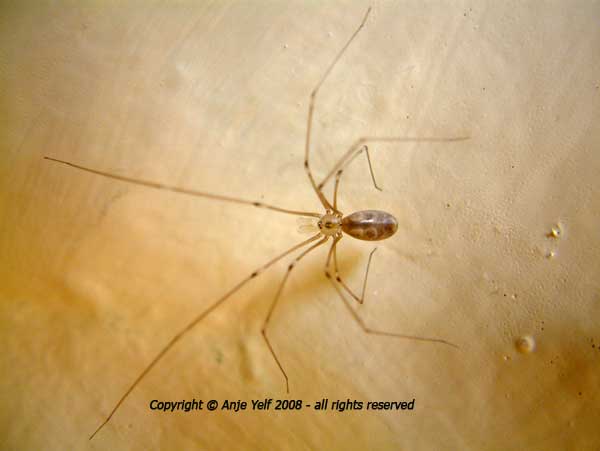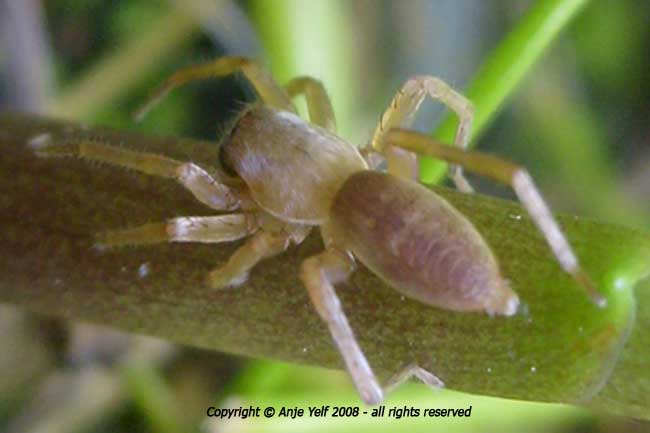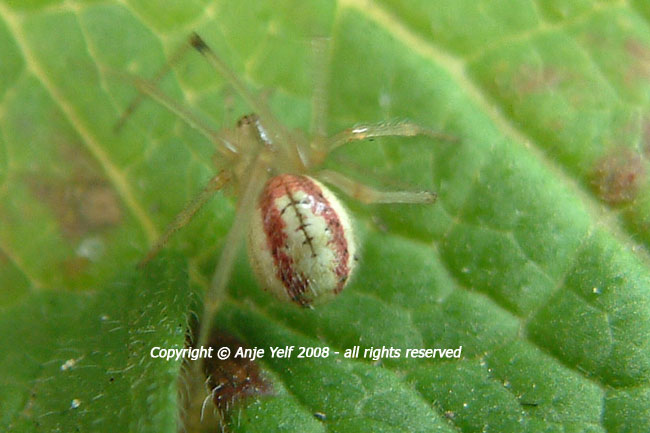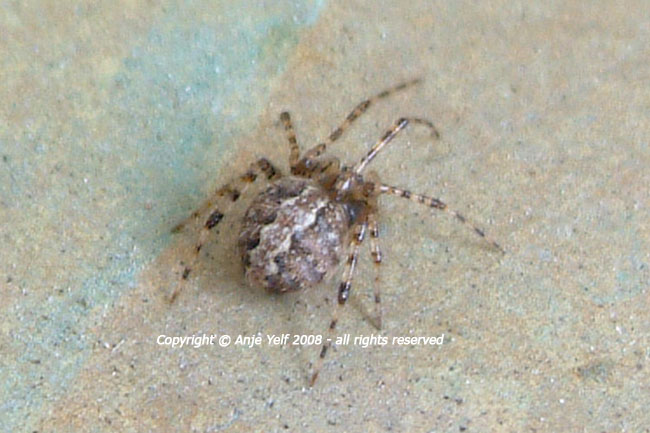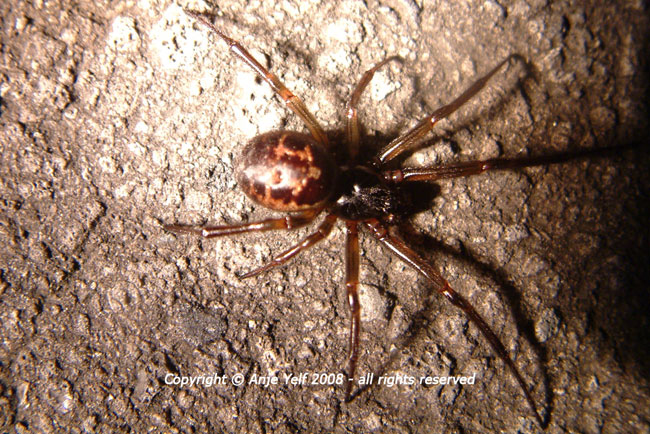Arachnids in my Garden
Orb Web Spiders | Crab Spiders | Tube Spiders | Lace Weaver Spiders
Jumping Spiders | Sheet Spiders | Sac Spiders | Comb Footed Spiders
Araneus Diadematus |
The Orb Web Spider Araneus Diadematus is a common garden spider, which spins a large web in relation to its own size; normal size range 8mm to 20mm. The males are significantly smaller than the females and male fatalities can occur during courtship. Eggs are laid in the autumn and the female will guard her eggs; refusing to leave them to hunt, until she dies. In the following May, newly hatched spiders are coloured yellow with a dark patch on the abdomen. |
Araneus Cucurbitina |
This lime green orb web spider called Araneus Cucurbitina was found on my Iceburg Floribunda rose in the front garden. Identification was made upon discovery of the characteristic red dot on the spinnerets, so this one is an adult.They are usually anything from 4mm to 11mm in size. This one was about 7mm so might have some growing to do. Judging by the large abdomen, I would say it is a female. It constructs a small orb web, which only has a couple of spirals. |
Zygiella x-notata |
Zygiella x-notata is a common european spider. The cephalothorax is a yellow-brown, with a leaf-like mark on the opisthosoma. Zygiella x-notata females can grow up to 11mm in size and males up to 7mm. This specimen has a body length of 5mm so has some growing to do. Judging by the rounded abdomen, I would say it is a female. It's habitat is in the neighbourhood of houses and other similiar structures including boats.This one was found under my window sill, at the front of the house. It is the only orb web spider that continues to make web throughout the winter months. Their web is similar to that of the Garden Spider, Araneus Diadematus, but two sectors are always missing. The missing sectors contain the 'signalling'thread that the spider uses to detect prey snared in the web. However, juveniles and sometimes young adults tend to create whole webs. Zygiella x-notata is a nocturnal animal, constructing it's web at night or in the early hours of the morning. During the day it sits in its retreat, but will grab any prey that becomes ensnared in their web and drag it back to it's retreat for consumption. |
Zygiella atrica |
Zygiella atrica is a common european orb web spider. It is browner than Zygiella x-notata. They live in vegetation away from human habitation eg; bushes. This one was found in my Golden Privet hedge, at the front of the house. Their web is similar to that of Zygiella x-notata. The spider waits in its retreat, which is at the end of a thread linked to the web. Any insect that becomes ensnared in their web is subdued and dragged to it's retreat for consumption. This specimen has a body length of approximately 7mm, but I saw another with a body length of 10mm. Judging by the rounded abdomen, I would say it is a female. |
Misumena vatia - Male |
The Thomisus Crab Spider is also commonly known as the 'flower spider' or 'goldenrod spider'. This is a much smaller spider with a length of 3 to 6 mm. There are several species in Britain. These spiders do not spin webs, but instead sit on flowers and hunt by ambushing their prey. They have shorter and broader third and forth legs and longer first and second legs. All crab spiders hold their legs outstretched and can move in any direction. They have the ability to change their colouration depending upon the flower that they use; many are coloured white, green or yellow to blend with flowers of the similiar colour. However some have mastered various shades of pink. I've now been able to identify this as a male Misumena vatia crab spider. |
Misumena vatia - Female |
This female was seen in April in my courtyard garden. A pure white spider also known as the White Death Spider is 9mm in body length and approx 18mm in width. They hunt by ambushing their prey and subdue by a venonmous bite. The spider then holds its 'lunch' and sucks it dry.The main diet comprises of flies, butterflies, moths, grasshoppers and bees. I believe this type is the largest of the Crab Spiders. |
Cocoon of Misumena vatia |
In spring, after mating, the abdomen of the spider swelled and the female then spins a silk cocoon to protect her eggs. Having laid the eggs, she then ceases to feed and guards the eggs until she dies. This female used a Peony leaf to create a cocoon for her eggs. She bent the leaf over and secured using spun silk. Gradually, more silk was applied and she tightened the threads drawing the two sides together. This image shows the threads on one side, but both sides were secured. Eventually, the two sides were completely drawn together and she sat guarding her eggs, which were contained inside. She lost weight and her abdomen looked shrunken and somewhat emaciated. I saw her feed only the once when a fly got too close, but she did not stray away from the eggs. |
Diaea Dorsata |
This one was found on Christmas day wondering around the kitchen floor. Identified as a male Diaea Dorsata; one of the smallest crab spiders, which inhabits the edges of woodland. This one is likely to have arrived with the Christmas Tree and had been navigating around the house for a couple of weeks. |
Philodromus Cespitum or p. Aureolus |
This is a Running Crab spider. The first two pairs of legs are directed forward and although a crab spider it is not so obvious as the related Thomisidae species. It tends to move in a forward direction and rarely sideways. This spider has eight black eyes arranged in two rows of four. It is an active hunter and can move very quickly through vegetation to pursue its prey and does not create a web or snare. This specimen, which I think is a female, was one of several that had claimed my Golden Rod in the courtyard garden at the back of my house. |
Philodromus Cespitum or p. Aureolus |
A Running Crab spider. The spiders in this family are difficult to identify correctly. In fact you can that is true of most spiders. Philodromus aureolus and p.cespitum like to lurk in vegetation, particulary bushes, trees and plants. They are a fairly common spider in England. After doing a spot of gardening; cutting back the growth of my geraniums, this lovely spider was rescued from the bag of garden refuse. |
Segestria Florentina |
This Segestria Florentina (male shown approximately 15mm in length) spider was found out of its tube on the front door after dark, which is not surprising as they are nocturnal. There are several tube webs created in the exterior walls around my home. The spider normally waits in it's tube web with six legs forward touching the lines of silk which radiate from the edge of the web. Launching itself forward onto any suitable prey that should touch the web and dragging it back into the tube to consume. Generally it feeds on small insects and beetles, but doesn't seem to like the taste of woodlice! It has six eyes and its jaws are an iridescent green (can be seen if you shine a torch down its web at night). The female (length 15mm - 22mm but can be much larger) will lay her eggs inside the tube and guard them until they hatch and disperse but if she dies first then she will be their first meal. This spider was first sited around ports in southern England in about 1845 suggesting its entry to our shores was via boat from the continent. It has been reported as producing a nasty bite which was painful and red, but subsided after 6 hours. |
Segestria Senoculata |
This is another tube or funnel web spider called Segestria Senoculata. Sometimes it is called the 'Snake's back spider' due to the distinctive adder like markings along the back of the abdomen. This species is one of the six-eyed spiders. This spider was found out of its tube wandering about after dark as they are nocturnal. The spider uses radiating silken trip lines to detect prey, which if detected, the spider rushes out from it's tube and drags the prey back into its tunnel to feed. I winessed one of these wandering aound on the brick wall outside the front door. It came upon another tube funnel belonging to a Segestria Florentina. There was a brief encounter, which left the Segestria Florentina victorious and the Segestria Senoculata fell to a ledge from where it managed to reclimb the wall. It seemed unwell immediately after the encounter, rather shaken but at least it survived. |
Amaurobius Ferox - female |
The Amaurobius ferox is a large (18mm body length for female shown; males tend to be smaller 12mm), robust, black lace weaver spider with a vague pattern on the abdomen and large firm stocky legs. They are active at night, but the specimen I photographed was discovered in my courtyard garden, under a large metal saucer shaped water container during the day. It probably thought it had found a safe retreat under its own web. These spiders inhabit holes in walls, crevices, under bark, rubbish and in cellars. They make a cribellate web by combing the characteristic woolly silk they produce, using a row of stiff hairs (the comb) located on their rear legs. The silk has a blueish hue and the web can appear spread out and messy over a basic funnel. Any unsuspecting prey that is unfortunate to trespass onto the web soon becomes entangled as the woolly texture of the silk catches upon any hairs; the more the prey struggles to free itself, the more enmeshed it becomes. Finally, the spider moves in for the kill. Females can be found throughout the year, but males are usually seen in the spring or autumn. They leave their webs and search for females. The adult male can be identified by the swollen pedipalps, which contain the copulatory organs and look like boxing gloves. There has been much research into the behaviour of the mother spider. It has been found that the spiderlings appear to stimulate the mother to produce a second batch of trophic eggs as food for her spiderlings. After providing this meal for her offspring, the mother spider then presses against the spiderlings actively encouraging them to kill and eat her. This selfless act is known as matriphagy or 'mother eating'. The mother spider offers herself as food. |
Zebra Spider |
The Jumping Spider Salticus Scenicus is also commonly known as the zebra spider, due to the black and white striped pattern. This is a much smaller 8 eyed spider with a length of 5 to 7 mm. The front two eyes are distinctly larger and it is thought that this improves their vision. There are four species in Britain, but this one is the most common. These spiders can perform a standing start jump in any direction to either avoid capture or stalk and kill prey. They are often found on sunny walls. |
Linyphia Triangularis |
The Linyphia Triangularis is a sheet web spider. They are often found in amongst hedges and bushes. Currently seeking further information as I believe this type of spider has an unusual mating ritual when securing a mate. |
Tegenaria Domestica |
This is perhaps the most common house spider that most people will recognise and it is the smallest of the species where the female can have a body length up to 11mm. Males are usually a little smaller with longer legs and a narrower abdomen. They are also seen all year round. This one was living just outside my front door until it suddenly disappeared and instead I saw a Segestria Florentina lurking about which had just shed its skin, leaving it on the house spider web, but then it retreated to its own nearby funnel. Not sure what happened here, but it is the same Segestria Florentina that had a fight with a wandering Segestria Senoculata. The Tegenaria domestica creates a flat sheet web attached to a funnel at one end and is a nocturnal spider. When any potential prey strays into the web, the spider will rush out of the funnel at speed and attack the prey. The common house spider is a tough species and can survive for months without food. Females have been known to live for several years, but males who live quite happilly with the female for a couple of weeks prior to mating, die after mating and are sometimes eaten by the female. |
Pholcus Phalangioides |
Commonly called 'the daddy-long-legs spider' or 'cellar spider', Pholcus phalangiodes is a very common world wide spider. They are frequently seen living on ceilings or quiet dark corners in the home, shed or basement. Their horizontal webs are large, loose, and flat, but they can make them any shape to fit into surrounding objects. They hang upside down on the web and if disturbed, shake violently. Pholcus phalangioides is an eight eyed spider, which is a pale yellow-brown except for a gray patch in the center of the cephalothorax. The body and legs are almost translucent. The females are about 8 mm in length and males 6mm. These spiders are effective predators of houshold pests including other spiders. They throw silk at their victim, once snared then they'll bite, envenomating their prey - they'll even go out hunting other spiders including tegenaria species. They are also canabalistic, eating each other if food is scarce. On the other hand the females are excellent mother's. They carry their eggs in their mouths and have been seen feeding their young. |
Clubiona Compta |
Clubiona Compta is a sac spider. This is a common spider, but rather secretive. It is a nocturnal hunter, so during the day it hides under bark, stones and leaves (especially Ivy) where it creates a flat web close to the surface of the leaf or bark. The spider retreats to the relative safety of this space between the web and surface. It is a reddish brown spider with a cardiac mark, (an elongate midline mark on the anterior, dorsal surface of the abdomen, which overlies the heart) followed by chevons. During the Autumn, this spider can be seen crawling around on walls and vegetation. I'm not certain of the sex, but would guess that as the abdomen is not proportionally larger, this could be a male. |
Enoplognatha ovata |
Enoplognatha ovata is also known as the Candystripe spider due to red colouration found on some species. Other variants in colour include white, green, yellow and some red coloured species have one single wide red stripe as opposed to the more common two stripes. Note the dots on the sides indicating an adult. The egg sac is a distinctive blue-grey. This spider is a comb-footed spider, also known as cobweb spiders and tangle-web spiders (family Theridiidae). They got their name from the way they use a comb of serrated bristles found on the tarsus of the fourth leg. This comb is used to tease the silken threads over and around the stricken prey. It is a common garden spider that likes to construct its web in amongst plants. Their webs are constructed by attaching one end to the plant and allowing the rest of the web to dangle as a mesh of attached strands. Any unfortunate prey quickly become ensnared. The one photographed above was found amongst the geraniums in the front garden. |
Theridion Mystaceum or T.Melanurum |
I've not been able to clarify whether this spider was Theridion melanurum or T. mystaceum. They have been reported around houses and this one was seen in a niche on my front door. In Britain T. Melanurum has mainly a southern distribution. T. Mystaceum is more uncommon, but again more prevalent in southern counties and more typically recorded from bushes. Both T. Melanurum and T. Mystaceum are tangle web spiders found on tree trunks and vegetation, sometimes on buildings. T. Mystaceum was separated recently from the very similar indoor species T. Melanurum. |
Steatoda Nobilis |
The Theridiidae family includes the genus Latrodectus, the notorious widow spiders. Steatoda nobilis, otherwise called the Black False Widow spider. They are a large bulbous spider with a distinct marbling pattern on their abdomen. This specimen was about 12mm in body length. They construct cobwebs in and around houses and out-buildings and rely on vibrations to detect prey (flies and insects) as their eyesight is not good. They were originally unintentionally brought to this country, Torquay in Devon, from the Canary Islands in 1879.
They are not aggressive towards humans and prefer to flee, but can deliver a painful bite if accidentally squeezed etc. Regarded as the UK's most venomous spider. |


